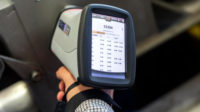On-site and real-time positive material identification (PMI) testing offers several advantages compared to sending samples to a laboratory for analysis. Some of the key benefits include:
- Faster Results: On-site PMI testing provides immediate results, enabling quick decision-making during critical phases of production or maintenance. This rapid turnaround time helps reduce downtime and keeps manufacturing processes running efficiently.
- Cost Savings: Eliminating the need to transport samples to a laboratory and wait for results can lead to significant cost savings. On-site testing reduces shipping expenses and minimizes production delays associated with waiting for laboratory reports.
- Real-Time Process Control: Real-time PMI testing allows manufacturers to monitor the composition of materials during the production process continuously. This helps ensure that materials used are in line with specifications, avoiding costly rework or product defects.
- Increased Productivity: On-site PMI testing streamlines quality control and inspection processes. It reduces the time and effort required for testing, freeing up resources for other essential tasks, and contributing to overall increased productivity.
"Compared to sending samples to a laboratory – either a contract lab or an internal facility – the greatest benefits of on-site PMI testing are time and testing volumes," says Matt Kreiner, head of global product management, Hitachi High-Tech. "Having PMI capabilities on-demand improves your responsiveness. The sooner you get results from your PMI equipment, the sooner you can act."
Organizations can test more of the plant more frequently with on-site PMI and do it more quickly than if they had to collect, catalog and send samples to a lab, Kreiner adds.
"The same equipment used to test process equipment can be used to test incoming material as it enters the warehouse to be sure that the shipment is exactly as specified and that it is stored in the right location," he explains.
For construction or repairs, companies can check the material on the ground before installation and test again to sign off that the work has been completed. This gets operations moving as quickly as possible, resulting in shorter turnarounds, less waste, less scrap, less resource consumption, and ultimately helps you meet commitments to your customers.
On-site and real-time PMI testing offers several advantages when compared to a lab-based analysis, says Esa Nummi, vice president, X-ray mobile and portable analyzers, Bruker Nano GmbH.
"Firstly, on-site testing is faster, as the results are available immediately, whilst sending samples to a laboratory can take days or even weeks. This allows for quicker decision-making and reduces any potential downtime."
On-site testing is also more cost-effective, as it eliminates the need to transport samples to a laboratory and to pay laboratory fees. It also reduces the risk of samples being lost or damaged during transport, Nummi explains.
NDT Series
Positive Material Identification
"In some cases, on-site PMI testing can even be more accurate than lab testing, as it eliminates the risk of sample contamination or change during sampling and transport," Nummi adds.
Finally, on-site testing using a portable system provides greater flexibility, as testing can be performed at any time or location. This is particularly beneficial for industries that require testing materials at multiple locations, such as construction and oil and gas.
Potentially the most important benefit is that personnel without any specialized knowledge can use the instruments involved in on-site PMI, leading to faster decisions on the production floor, and increased productivity, says Mathieu Bauer, senior application scientist and associate product manager for handheld XRF analyzers, Thermo Fisher Scientific.
"Real-time analysis also means manufacturers can adjust their operations to achieve the best outcome without waiting for laboratory results to come back," Bauer says. "Furthermore, nondestructive sampling with on-site PMI techniques allows staff to analyze more materials in less time, reducing the chance of missing weak spots that could lead to catastrophic failures."



